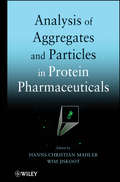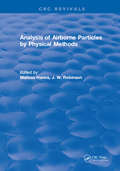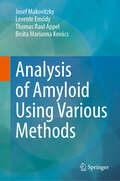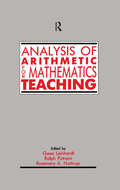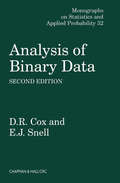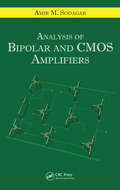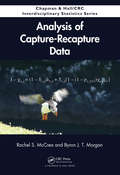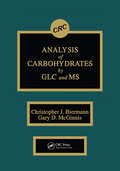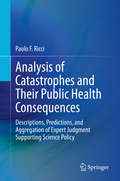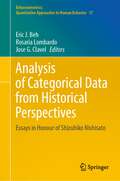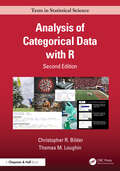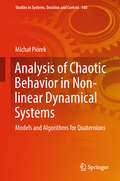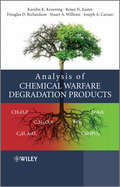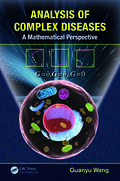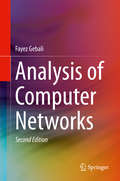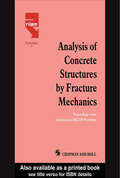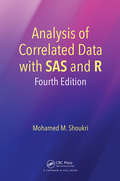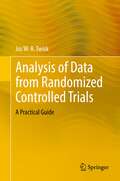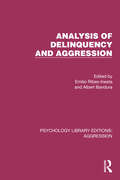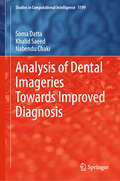- Table View
- List View
Analysis of Aggregates and Particles in Protein Pharmaceuticals
by Wim Jiskoot Hanns-Christian MahlerThis book describes how to address the analysis of aggregates and particles in protein pharmaceuticals, provides a comprehensive overview of current methods and integrated approaches used to quantify and characterize aggregates and particles, and discusses regulatory requirements. Analytical methods covered in the book include separation, light scattering, microscopy, and spectroscopy.
Analysis of Airborne Particles by Physical Methods
by Malissa HannsFirst Published in 2018. Routledge is an imprint of Taylor & Francis, an Informa company.
Analysis of Aircraft Structures
by Bruce K. DonaldsonAs with the first edition, this textbook provides a clear introduction to the fundamental theory of structural analysis as applied to vehicular structures such as aircraft, spacecraft, automobiles and ships. The emphasis is on the application of fundamental concepts of structural analysis that are employed in everyday engineering practice. All approximations are accompanied by a full explanation of their validity. In this new edition, more topics, figures, examples and exercises have been added. There is also a greater emphasis on the finite element method of analysis. Clarity remains the hallmark of this text and it employs three strategies to achieve clarity of presentation: essential introductory topics are covered, all approximations are fully explained and many important concepts are repeated.
Analysis of Amyloid Using Various Methods
by Josef Makovitzky Levente Emődy Thomas Raul Appel Beáta Marianna KovácsThis book explores the world of amyloid, consisting of heterogeneous deposits that have captivated scientists for decades. Amyloid, characterized by its highly organized insoluble protein fibrils exhibiting cross-layered quaternary beta-sheet structures, comprises diverse components such as the P-component, sialic acid, O-acyl sialic acid, and sGAG components. This assembly forms an anisotropic entity that induces birefringence in linearly polarized light, creating a distinctive optical signature. Initially linked to human disease and tissue damage, the predominant idea that amyloid only harms the host has been challenged. Recent pioneering studies have uncovered the existence of functional amyloid fibers in unexpected domains, from bacteria to mammals. Advances during the 1960s and 1970s, along with seminal immunohistochemical investigations, gave impetus to immunobiological analysis of amyloid in the 1980s. Notable work, such as the exploration of amyloid fiber staining techniques and the comprehensive study of histochemical properties, have enriched the understanding of this enigmatic deposit. The book presents a current overview of amyloid research in health and disease, with contributions from the prestigious biennial Amyloid Forum. Written by a distinguished researcher with nearly five decades of experience, the book encompasses five meticulously elaborated chapters. From human and animal deposits to bacterial formations, isolated fibrils, prions, and amyloid-related neurodegenerative disorders, each category of deposit is given a thorough examination. Innovative topo-optical staining techniques - polarization microscopy, fluorescence microscopy and confocal laser scanning fluorescence microscopy - reveal intricate structures in all species. Coherent structural features are authenticated by various staining reactions and different digestions. A key segment dissects animal prion fibers, revealing their intricate architecture by topo-optical reactions and uncovering selective arrangements of components. To complete this, the book confirms the postulated helical structure of the amyloid fiber. This innovative idea is validated by laser scanning confocal fluorescence microscopy, which reveals ordered and helically stacked amyloid protein fibrils in β-sheet conformation. Associations with chondroitin, heparan sulfate, and looser sphingolipid linkages further unravel the structural complexities of amyloid. Also offers an insightful journey into the realm of amyloid, combining historical knowledge with cutting-edge methodologies, redefining the understanding of this intricate phenomenon.
Analysis of Antioxidant-Rich Phytochemicals
by Zhimin Xu Luke R. HowardTo quantify antioxidants in natural sources, the application of chromatography techniques with different detectors followed by skillful sample preparation is necessary. Analysis of Antioxidant-Rich Phytochemicals is the first book that specifically covers and summarizes the details of sample preparation procedures and methods developed to identify and quantify various types of natural antioxidants in foods. Focusing on the principle of quantification methods for natural antioxidants, the book reviews and summarizes current methods used in the determination of antioxidant-rich phytochemicals in different sources. Chapter by chapter, the distinguished team of authors describes the various methods used for analysis of the different antioxidant-rich phytochemicals – phenolic acids; carotenoids; anthocyanins; ellagitannins, flavonols and flavones; catechins and procyanidins; flavanones; stilbenes; phytosterols; and tocopherols and tocotrienols. Going beyond extensive reviews of the scientific literature, the expert contributors call on their accumulated experience in sample extraction and analysis to outline procedures, identify potential problems in dealing with different samples, and offer trouble-shooting tips for the analysis. Analysis of Antioxidant-Rich Phytochemicals covers the important food applications and health-promoting functions of the major antioxidant phytochemicals, presents general analysis principles and procedures, and systematically reviews and summarizes the various analytical methods necessary for each type of natural antioxidant in different food sources.
Analysis of Arithmetic for Mathematics Teaching
by Gaea LeinhardtThis volume emerges from a partnership between the American Federation of Teachers and the Learning Research and Development Center at the University of Pittsburgh. The partnership brought together researchers and expert teachers for intensive dialogue sessions focusing on what each community knows about effective mathematical learning and instruction. The chapters deal with the research on, and conceptual analysis of, specific arithmetic topics (addition, subtraction, multiplication, division, decimals, and fractions) or with overarching themes that pervade the early curriculum and constitute the links with the more advanced topics of mathematics (intuition, number sense, and estimation). Serving as a link between the communities of cognitive researchers and mathematics educators, the book capitalizes on the recent research successes of cognitive science and reviews the literature of the math education community as well.
Analysis of Binary Data (Chapman And Hall/crc Monographs On Statistics And Applied Probability Ser. #32)
by D.R. CoxThe first edition of this book (1970) set out a systematic basis for the analysis of binary data and in particular for the study of how the probability of 'success' depends on explanatory variables. The first edition has been widely used and the general level and style have been preserved in the second edition, which contains a substantial amount of new material. This amplifies matters dealt with only cryptically in the first edition and includes many more recent developments. In addition the whole material has been reorganized, in particular to put more emphasis on m.aximum likelihood methods.There are nearly 60 further results and exercises. The main points are illustrated by practical examples, many of them not in the first edition, and some general essential background material is set out in new Appendices.
Analysis of Biomarker Data
by Stephen W. Looney Joseph L. HaganA "how to" guide for applying statistical methods to biomarker data analysisPresenting a solid foundation for the statistical methods that are used to analyze biomarker data, Analysis of Biomarker Data: A Practical Guide features preferred techniques for biomarker validation. The authors provide descriptions of select elementary statistical methods that are traditionally used to analyze biomarker data with a focus on the proper application of each method, including necessary assumptions, software recommendations, and proper interpretation of computer output. In addition, the book discusses frequently encountered challenges in analyzing biomarker data and how to deal with them, methods for the quality assessment of biomarkers, and biomarker study designs. Covering a broad range of statistical methods that have been used to analyze biomarker data in published research studies, Analysis of Biomarker Data: A Practical Guide also features:A greater emphasis on the application of methods as opposed to the underlying statistical and mathematical theoryThe use of SAS®, R , and other software throughout to illustrate the presented calculations for each exampleNumerous exercises based on real-world data as well as solutions to the problems to aid in reader comprehensionThe principles of good research study design and the methods for assessing the quality of a newly proposed biomarkerA companion website that includes a software appendix with multiple types of software and complete data sets from the book's examplesAnalysis of Biomarker Data: A Practical Guide is an ideal upper-undergraduate and graduate-level textbook for courses in the biological or environmental sciences. An excellent reference for statisticians who routinely analyze and interpret biomarker data, the book is also useful for researchers who wish to perform their own analyses of biomarker data, such as toxicologists, pharmacologists, epidemiologists, environmental and clinical laboratory scientists, and other professionals in the health and environmental sciences.
Analysis of Bipolar and CMOS Amplifiers
by Amir M. SodagarThe classical approach to analog circuit analysis is a daunting prospect to many students, requiring tedious enumeration of contributing factors and lengthy calculations. Most textbooks apply this cumbersome approach to small-signal amplifiers, which becomes even more difficult as the number of components increases. Analysis of Bipolar and CMOS Amplifiers offers students an alternative that enables quick and intuitive analysis and design: the analysis-by-inspection method.This practical and student-friendly text demonstrates how to achieve approximate results that fall within an acceptable range of accuracy and are based on sound scientific principles. Working from the basics of amplifiers and transistors to biasing, single- and multistage amplifiers, current sources and mirrors, and analysis at midband, low, and high frequencies, the author demonstrates the interrelationship between behavior in both the time and frequency domains and balances the discussion between bipolar and CMOS circuits. Each chapter closes with a set of simulation examples in SPICE and MATLAB® that give students hands-on experience applying the concepts and methods using industry-standard tools.Building a practical working knowledge around a solid theoretical framework, Analysis of Bipolar and CMOS Amplifiers prepares your students to meet the challenges of quick and accurate approximations and software-based analysis awaiting them in the workplace.
Analysis of Boolean Functions
by Ryan O'DonnellBoolean functions are perhaps the most basic objects of study in theoretical computer science. They also arise in other areas of mathematics, including combinatorics, statistical physics, and mathematical social choice. The field of analysis of Boolean functions seeks to understand them via their Fourier transform and other analytic methods. This text gives a thorough overview of the field, beginning with the most basic definitions and proceeding to advanced topics such as hypercontractivity and isoperimetry. Each chapter includes a "highlight application" such as Arrow's theorem from economics, the Goldreich-Levin algorithm from cryptography/learning theory, Håstad's NP-hardness of approximation results, and "sharp threshold" theorems for random graph properties. The book includes roughly 450 exercises and can be used as the basis of a one-semester graduate course. It should appeal to advanced undergraduates, graduate students, and researchers in computer science theory and related mathematical fields.
Analysis of Cancer Risks in Populations Near Nuclear Facilities: Phase 2 Pilot Planning
by Committee on the Analysis of Cancer Risks in Populations Near Nuclear Facilities-Phase 2 Pilot PlanningAnalysis of Cancer Risks in Populations near Nuclear Facilities is a pilot study requested by the United States Nuclear Regulatory Commission (USNRC) to assess the risk of cancer near nuclear facilities in the United States.<P><P> This effort is being carried out in two phases. The Phase 1 study recommended two study designs appropriate for assessing cancer risks near nuclear facilities. It also recommended a pilot study of seven nuclear facilities to assess the technical feasibility of the recommended study designs. The Phase 2 study is the assessment of cancer risks.
Analysis of Capture-Recapture Data (Chapman & Hall/CRC Interdisciplinary Statistics)
by Rachel S. McCrea Byron J. MorganAn important first step in studying the demography of wild animals is to identify the animals uniquely through applying markings, such as rings, tags, and bands. Once the animals are encountered again, researchers can study different forms of capture-recapture data to estimate features, such as the mortality and size of the populations. Capture-rec
Analysis of Carbohydrates by GLC and MS
by Christopher J. Biermann Gary D. McGinnisThis textbook is a comprehensive guide to analysis of carbohy-drates by gas-liquid chromatography and mass spectrometry. In addition to explaining the facets of carbohydrate analysis and their relation to each other, the text also contains in-depth reference in-formation useful to practitioners in the field. Improvements in car-bohydrate analyses methodology during the past six years are also highlighted. This extensively illustrated text provides excellent data for those in carbohydrate, agriculture, and food chemistry.
Analysis of Catastrophes and Their Public Health Consequences: Descriptions, Predictions, and Aggregation of Expert Judgment Supporting Science Policy
by Paolo F. RicciPublic health policy prospectively and retrospectively addresses the consequences of events ranging from the commonplace to the catastrophic. Informing policymakers and stakeholders by enhancing their understanding of complex causation to justify remedial or precautionary actions is a critical science-policy task. In this book, the key aspects of catastrophes (regardless of their nature) and routine events are identified through a common framework for their analyses, and the analyses of the consequences associated with the potential occurrence of these events also are discussed. The book is not about disaster planning; instead, it is focused on analysis and causation in the context of informing – rather than formulating – public health policy. The author aggregates and fuses scientific information and knowledge in public health policy-science using alternative but complementary methods. The book first focuses on the analysis of catastrophes and commonplace events; the focus then shifts to causal models of multifactorial diseases, particularly at low doses or dose-rates, associated with these events. Topics explored among the chapters include:Policy and Legal Aspects of Precautionary ChoicesCatastrophes, Disasters, and Calamities: Concepts for Their Assessment Uncertainty: Probabilistic and Statistical AspectsAggregating Judgments to Inform Precautionary Decision-makingThe aim of the book is to show that the analyses of events are fundamentally similar, regardless of whether the concern is a global catastrophe or commonplace. Analysis of Catastrophes and Their Public Health Consequences is a text that should engage students, instructors, and researchers in public health, science policy, and preparedness research, as well as serve as a useful resource for policy analysts, practitioners, and risk managers.
Analysis of Categorical Data from Historical Perspectives: Essays in Honour of Shizuhiko Nishisato (Behaviormetrics: Quantitative Approaches to Human Behavior #17)
by Eric J. Beh Rosaria Lombardo Jose G. ClavelThis collection of essays is in honor of Shizuhiko Nishisato on his 88th birthday and consists of invited contributions only. The book contains essays on the analysis of categorical data, which includes quantification theory, cluster analysis, and other areas of multidimensional data analysis, covering more than half a century of research by the 41 interdisciplinary and international researchers who are contributors. Thus, it offers the wisdom and experience of work past and present and attracts a new generation of researchers to this field. Central to this wisdom and experience is that of Prof. Nishisato, who has spent much of the past 60 years mentoring and providing leadership in the research of quantification theory, especially that of “dual scaling”. The book includes contributions by leading researchers who have worked alongside Prof. Nishisato, published with him, been mentored by him, or whose work has been influenced by the research he has undertaken over his illustrious career. This book inspires researchers young and old as it highlights the significant contributions, past and present, that Prof. Nishisato has made in his field.
Analysis of Categorical Data with R (Chapman & Hall/CRC Texts in Statistical Science)
by Christopher R. Bilder Thomas M. LoughinAnalysis of Categorical Data with R, Second Edition presents a modern account of categorical data analysis using the R software environment. It covers recent techniques of model building and assessment for binary, multicategory, and count response variables and discusses fundamentals, such as odds ratio and probability estimation. The authors give detailed advice and guidelines on which procedures to use and why to use them.The second edition is a substantial update of the first based on the authors’ experiences of teaching from the book for nearly a decade. The book is organized as before, but with new content throughout, and there are two new substantive topics in the advanced topics chapter—group testing and splines. The computing has been completely updated, with the "emmeans" package now integrated into the book. The examples have also been updated, notably to include new examples based on COVID-19, and there are more than 90 new exercises in the book. The solutions manual and teaching videos have also been updated.Features: Requires no prior experience with R, and offers an introduction to the essential features and functions of R Includes numerous examples from medicine, psychology, sports, ecology, and many other areas Integrates extensive R code and output Graphically demonstrates many of the features and properties of various analysis methods Offers a substantial number of exercises in all chapters, enabling use as a course text or for self-study Supplemented by a website with data sets, code, and teaching videos Analysis of Categorical Data with R, Second Edition is primarily designed for a course on categorical data analysis taught at the advanced undergraduate or graduate level. Such a course could be taught in a statistics or biostatistics department, or within mathematics, psychology, social science, ecology, or another quantitative discipline. It could also be used by a self-learner and would make an ideal reference for a researcher from any discipline where categorical data arise.
Analysis of Chaotic Behavior in Non-linear Dynamical Systems: Models and Algorithms for Quaternions (Studies in Systems, Decision and Control #160)
by Michał PiórekThis book presents a new approach for the analysis of chaotic behavior in non-linear dynamical systems, in which output can be represented in quaternion parametrization. It offers a new family of methods for the analysis of chaos in the quaternion domain along with extensive numerical experiments performed on human motion data and artificial data. All methods and algorithms are designed to allow detection of deterministic chaos behavior in quaternion data representing the rotation of a body in 3D space. This book is an excellent reference for engineers, researchers, and postgraduate students conducting research on human gait analysis, healthcare informatics, dynamical systems with deterministic chaos or time series analysis.
Analysis of Chemical Warfare Degradation Products
by Joseph A. Caruso Renee N. Easter Stuart A. Willison Douglas D. Richardson Karolin K. KroeningThis book describes nerve agents and vesicants, their decomposition and their degradation products' chemistry as well as their toxicity including a list of detection techniques of nerve agents and their degradation products. This book will present their history, toxicity, comparison between different sample preparation methods, separation techniques, and detection methods all together in a short, easy to read book, tied together by a single group doing the writing and the editing to assure smooth transition from chapter to chapter, with sufficient Tables and literature references for the reader who looks to further detail.The text will illustrate the pluses and minuses of the various techniques with sufficient references for the reader to obtain extensive detail.
Analysis of Complex Diseases: A Mathematical Perspective
by PhD, Guanyu WangA complex disease involves many etiological and risk factors operating at multiple levels-molecular, cellular, organismal, and environmental. The incidence of such diseases as cancer, obesity, and diabetes are increasing in occurrence, urging us to think fundamentally and use a broader perspective to identify their connection and revolutionize trea
Analysis of Computer Networks
by Fayez GebaliThis textbook presents the mathematical theory and techniques necessary for analyzing and modeling high-performance global networks, such as the Internet. The three main building blocks of high-performance networks are links, switching equipment connecting the links together and software employed at the end nodes and intermediate switches. This book provides the basic techniques for modeling and analyzing these last two components. Topics covered include, but are not limited to: Markov chains and queuing analysis, traffic modeling, interconnection networks and switch architectures and buffering strategies.
Analysis of Concrete Structures by Fracture Mechanics: Proceedings of a RILEM Workshop dedicated to Professor Arne Hillerborg, Abisko, Sweden 1989
by S. P. Shah L. ElfgrenThis book presents the latest research findings of the fast developing applications of fracture mechanics to concrete structures. Key papers from leading experts in the field describe existing and new modelling techniques in the analysis of materials and structures. The book explains the practical application of fracture mechanics to structural mod
Analysis of Correlated Data with SAS and R
by Mohamed M. ShoukriAnalysis of Correlated Data with SAS and R: 4th edition presents an applied treatment of recently developed statistical models and methods for the analysis of hierarchical binary, count and continuous response data. It explains how to use procedures in SAS and packages in R for exploring data, fitting appropriate models, presenting programming codes and results. The book is designed for senior undergraduate and graduate students in the health sciences, epidemiology, statistics, and biostatistics as well as clinical researchers, and consulting statisticians who can apply the methods with their own data analyses. In each chapter a brief description of the foundations of statistical theory needed to understand the methods is given, thereafter the author illustrates the applicability of the techniques by providing sufficient number of examples. The last three chapters of the 4th edition contain introductory material on propensity score analysis, meta-analysis and the treatment of missing data using SAS and R. These topics were not covered in previous editions. The main reason is that there is an increasing demand by clinical researchers to have these topics covered at a reasonably understandable level of complexity. Mohamed Shoukri is principal scientist and professor of biostatistics at The National Biotechnology Center, King Faisal Specialist Hospital and Research Center and Al-Faisal University, Saudi Arabia. Professor Shoukri’s research includes analytic epidemiology, analysis of hierarchical data, and clinical biostatistics. He is an associate editor of the 3Biotech journal, a Fellow of the Royal Statistical Society and an elected member of the International Statistical Institute.
Analysis of Data from Randomized Controlled Trials: A Practical Guide
by Jos W.R. TwiskThis book provides a practical guide to the analysis of data from randomized controlled trials (RCT). It gives an answer to the question of how to estimate the intervention effect in an appropriate way. This problem is examined for different RCT designs, such as RCTs with one follow-up measurement, RCTs with more than one follow-up measurement, cluster RCTs, cross-over trials, stepped wedge trials, and N-of-1 trials. The statistical methods are explained in a non-mathematical way and are illustrated by extensive examples. All datasets used in the book are available for download, so readers can reanalyse the examples to gain a better understanding of the methods used. Although most examples are taken from epidemiological and clinical studies, this book is also highly recommended for researchers working in other fields.
Analysis of Delinquency and Aggression (Psychology Library Editions: Aggression)
by Albert Bandura Emilio Ribes-InestaOriginally published in 1976, this volume is organized about two central themes: the experimental analysis of aggression, and the application of learning principles to the prevention and modification of delinquency. The chapters, all new and original at the time, demonstrate how the problems of aggression, which had been interpreted in diverse ways, can be analyzed under controlled laboratory conditions. In addition, the contributors offer an explanation of how behavior modification techniques, derived from this knowledge, can be used for preventive purposes.Because of the social nature of aggression and delinquency, behavior change techniques were principally aimed at modifying environmental influences. The contributions to this volume illustrate how behavioral scientists may aid in the understanding and amelioration of conditions that give rise to violence. Today it can be read and enjoyed in its historical context.
Analysis of Dental Imageries Towards Improved Diagnosis (Studies in Computational Intelligence #1199)
by Khalid Saeed Nabendu Chaki Soma DattaThis book provides an insight on different types of hardware and software-based caries detection methods and their limitations from treatment perspective. The different chapters are motivated to address some of the important gaps in the prevailing approaches and suggest suitable solution to them. Overall, it helps the reader to understand the caries detection methods to identify interproximal and occlusal caries. This also assists the practitioners. The book identifies multiple research issues on dental caries detection that open the practitioners’ horizons to an array of domains from which they can conclude practical insights about their area of interest.
